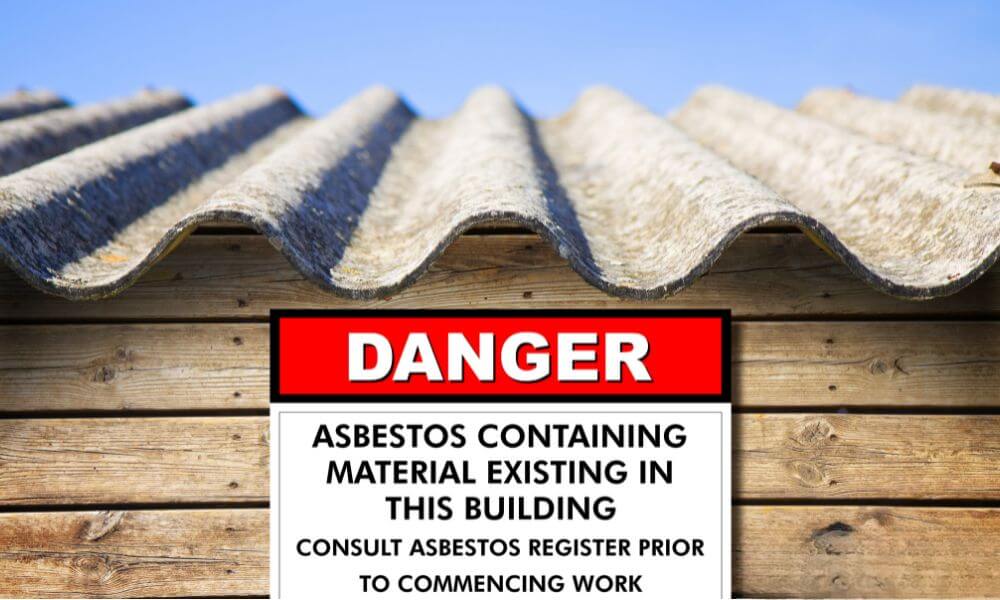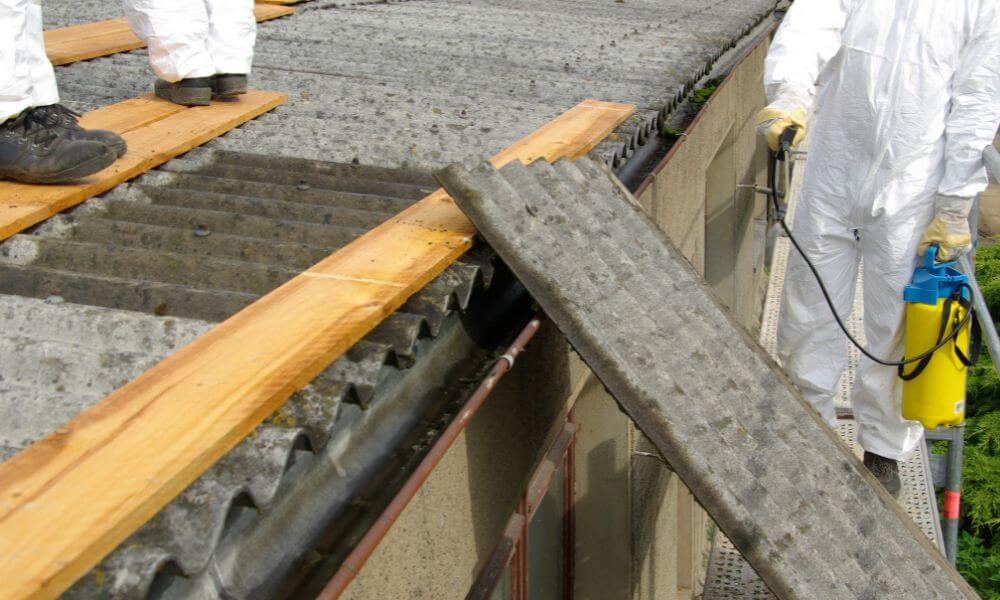What does asbestos look like? Asbestos looks like thin, bundled, white, silver, brown, or blue fibers. However, identifying asbestos by sight alone can be very challenging, especially when it’s mixed with other building materials. Therefore, professional testing is typically required to confirm its presence.
What Does Asbestos Look Like?
Asbestos is a naturally occurring mineral composed of thin, durable fibers. Depending on its type, its color can range from shiny silver to white or even dark brown or blue. The fibers are typically bundled together, and when disturbed, they can easily crumble into a powdery substance.
Types of Asbestos
Six types of asbestos may be found in residential or commercial properties: Chrysotile, Amosite, crocidolite, anthophyllite, tremolite, and actinolite.
Chrysotile (White Asbestos)
First up is Chrysotile, also known as white asbestos. This is the most commonly used type and accounts for around 95% of the asbestos in the United States.
Amosite (Brown Asbestos)
Then there’s Amosite or brown asbestos. It’s predominantly sourced from South Africa and is the second most commonly used type.
Crocidolite (Blue Asbestos)
Crocidolite, or blue asbestos, is considered the most dangerous due to its fine fibers that can easily be inhaled. It’s predominantly found in Australia, South Africa, and Bolivia.
Anthophyllite Asbestos
Anthophyllite asbestos is one of the rarest forms and has limited commercial usage. It’s commonly associated with metamorphic rocks.
Tremolite and Actinolite Asbestos
Finally, we have Tremolite and Actinolite. These types are less common and not typically used commercially. However, they can sometimes be found as contaminants in other asbestos materials.
Remember, these types can only sometimes be identified just by looking, and professional testing is needed to confirm their presence.
How to identify asbestos?
Identifying asbestos in a home or building can be challenging because it is often mixed with other materials. However, you can make an educated guess based on a few tell-tale signs. Here’s how you might identify potential asbestos:
Age of the Property
Asbestos was extensively used in buildings and homes from the 1920s to the 1980s. If your property falls within this age range, it could contain asbestos.
Building Materials
Asbestos was commonly used in specific building materials such as insulation, ceiling and floor tiles, cement sheets, pipe insulation, and textured paints.
Visual Inspection
Some asbestos materials are fluffy and may be white or gray. Asbestos ceiling tiles, siding, and roofing tiles might show a wavy, corrugated pattern. But remember, visual identification is only sometimes accurate.
Asbestos Produces Unusual Sound
Materials containing asbestos, like tiles, produce a distinct, high-pitched sound when they knock together.
While these pointers can give you an initial indication, professional testing is the only surefire way to identify asbestos. If you suspect the presence of asbestos in your home or building:
- Do not disturb it by drilling, sawing, sanding, or breaking apart the material. This can release asbestos fibers into the air.
- Contact a professional asbestos surveyor who can safely take samples without causing unnecessary risk.
- If the material is confirmed to contain asbestos and is damaged or you plan to renovate, hire an accredited asbestos abatement contractor to remove or encapsulate it safely.
Remember, asbestos is a hazardous material, and its handling should be left to professionals to ensure safety.
What does asbestos tile look like?
Asbestos tile, commonly used in the mid-20th century for floor and ceiling applications, has certain characteristic features. However, it’s important to note that visually identifying asbestos-containing materials (ACM), including tile, is not always reliable. Professional testing is often required to confirm the presence of asbestos. Here are some common characteristics:
Size of Tiles
Asbestos tiles were commonly produced in a 9-inch by 9-inch size but could also be found in 12-inch by 12-inch squares. This size is less common in modern tiles.
Age of Building
If the building was constructed between the 1920s and the 1980s, there’s a higher chance that the tiles could contain asbestos, as it was a popular construction material.
Color and Pattern of Tiles
Asbestos tiles can come in various colors and patterns, but they often need to be more varied and smooth. They can sometimes appear in darker colors with small, abstract, asymmetrical patterns.
Thickness of Tiles
Asbestos tiles tend to be thinner than many modern tiles. They typically have a thickness of 1/8 inch.
Sound Produced by Tiles
Asbestos tiles often produce a distinct, high-pitched clinking sound when knocked against each other due to their mineral content.
Resilience of Tiles
Asbestos tiles are durable and resist damage from heat and chemicals.
Please note that these characteristics can give a hint, but the only definitive way to determine if a tile contains asbestos is through professional testing. If you suspect asbestos in your home, it’s recommended not to disturb it since damaged asbestos materials release fibers into the air, which can be hazardous when inhaled. Always seek help from a professional asbestos abatement company.
What does asbestos drywall look like?
Asbestos drywall, known as asbestos-containing plasterboard, gypsum board, or cement board, was commonly used in homes and buildings between the 1940s and 1980s. However, identifying asbestos drywall visually can be challenging because asbestos fibers are often mixed into the interior gypsum plaster material and are not visible to the naked eye. Here are some general characteristics to look out for:
Building’s Age
If the building or home was constructed or remodeled between the 1940s and the 1980s, there’s a higher likelihood that asbestos drywall could be present.
Appearance of Wall
Asbestos drywall usually looks like regular drywall. It may be covered with layers of paint or wallpaper. Asbestos was typically used in the ‘mud’ used to seal the joints between panels, so especially in older properties, thicker joint compounds or textured ‘popcorn’ finishes may contain asbestos.
Labeling on Asbestos
In some rare cases, asbestos products were labeled. Look for any manufacturer’s marks or stamps that might indicate the presence of asbestos. However, this is more likely with panels used in industrial settings and is unlikely in residential properties.
Remember, these are only general guidelines, and it’s impossible to identify asbestos drywall by sight or feel alone accurately. If you suspect your property has asbestos-containing materials, the safest approach is to treat the material as if it does contain asbestos and have it tested by a professional asbestos surveyor or an accredited laboratory.
If the material is damaged (i.e., crumbling or flaking), it’s crucial not to disturb it, as this can release asbestos fibers into the air. In such cases, contact a professional asbestos abatement contractor who can advise on the best course of action, whether encapsulation, repair, or removal.
What does an asbestos popcorn ceiling look like?
An asbestos popcorn ceiling, a stucco or cottage cheese ceiling, is a textured ceiling finish popular in homes and buildings from the late 1940s to the 1980s. Asbestos was often used in these ceilings due to its sound absorption properties and fire resistance. Here’s what to look for:
Texture of Popcorn Ceiling
Popcorn ceilings have a distinctive, bumpy texture that looks like cottage cheese or popcorn, hence the name. They often appear white or cream-colored but can be painted over.
Age of the Property
The popcorn ceiling might contain asbestos if your property was built or renovated between the late 1940s and 1980s. The U.S. Consumer Product Safety Commission banned asbestos in textured paint products in 1977. However, contractors could still use their existing supplies, so ceilings installed as late as the mid-1980s might contain asbestos.
Unusual Durability
Asbestos is highly heat, sound, and wear resistant. If your popcorn ceiling seems extraordinarily durable and resistant to damage, it could contain asbestos.
It’s important to remember that you cannot definitively tell if a popcorn ceiling contains asbestos simply by looking at it. If you suspect that your popcorn ceiling may contain asbestos, avoid touching, drilling into, scraping, or otherwise disturbing it, as this can release harmful asbestos fibers into the air.
To confirm the presence of asbestos, you should have a sample of the ceiling material professionally tested. If it tests positive for asbestos and you want it removed, it is highly recommended to hire a licensed asbestos abatement contractor to do the job. They will have the necessary training, equipment, and expertise to safely remove the asbestos without risking exposure.

Risks and Dangers of Asbestos Exposure
Asbestos exposure can lead to several health conditions, including asbestosis, lung cancer, and mesothelioma. Understanding these risks is vital, especially if you live or work in an environment where asbestos might be present.
Managing Asbestos Exposure
Professional Asbestos Management
If asbestos is identified in a building, professionals must handle its removal. They have the necessary training and equipment to ensure safe removal and disposal, minimizing the risk of exposure.
Personal Protection Measures
Wearing proper personal protective equipment is crucial for those who may come into contact with asbestos in their work. This can include respirators and protective clothing to prevent inhalation and contamination.
Health Effects of Asbestos Exposure
Asbestosis
Asbestosis is a chronic lung disease caused by inhaling asbestos fibers, which can cause scarring of lung tissue and shortness of breath.
Mesothelioma
Mesothelioma is a rare form of cancer that affects the lining of the lungs, chest cavity, or abdomen. It’s directly associated with asbestos exposure.
Lung Cancer
People exposed to asbestos have a higher risk of developing lung cancer, especially if they’re also smokers.
Legal Regulations on Asbestos
Many countries have implemented strict regulations on asbestos usage, and some have banned it altogether due to the health risks associated with exposure.
What to Do if You Suspect Asbestos
If you suspect asbestos in your home, don’t panic. Don’t try to remove it yourself, either, as this can be dangerous. Instead, hire an asbestos removal professional. They have the training and tools to handle and remove this hazardous material safely.
Asbestos Appearance : Conclusion
We have discussed in detail about what does asbestos look like? In essence, asbestos is a versatile mineral that has been utilized in various industries due to its impressive properties. However, its potential health risks have led to strict regulations and, in many cases, total bans. Awareness and precautions are essential when dealing with asbestos-containing materials.
Like our OHS Blog’s Facebook page | Home
